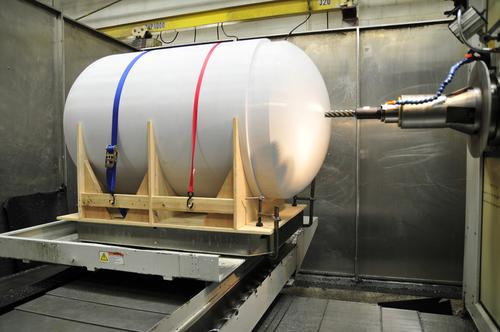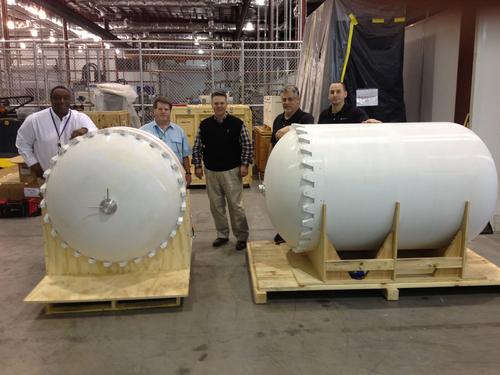Lockheed & RedEye Team to 3D-Print Rocket Fuel Tanks
June 2, 2014

It may not be the biggest object ever built with 3D printing, but it's definitely one of them. Lockheed Martin and service bureau RedEye have 3D-printed two huge rocket fuel tank prototypes, the biggest of which is 6.75 ft. long, using Stratasys's Fused Deposition Modeling (FDM) technology.
No, they didn't 3D-print an entire tank in one piece. That's still in the realm of science fiction. But Lockheed did save a bundle of money -- about half the cost -- and a lot of time by 3D printing the tanks in pieces and bonding them together, instead of machining them, according to RedEye's case study on the project. Considering how large those pieces are, that's not trivial. The biggest tank was made from ten pieces and the smaller one, with a length of 3.8 ft., was built from six pieces.

This different approach to building a satellite is part of an effort by Lockheed to increase the satellite's payload by making the use of space in it more efficient. That meant testing several assembly configurations and building multiple prototypes, or simulators, for different sections, including the fuel tanks. It also meant multiple form, fit, and function validation tests. The larger tank measures 6.75 ft. x 3.8 ft. x 3.8 ft., and the smaller is 3.8 ft. x 3.8 ft. x 3.8 ft. Using traditional machining methods to make the tank simulators would be too expensive -- $250,000 -- and take too long -- six months.
Although Lockheed's Space System Company has used the FDM process via RedEye, and also via the FDM machines it owns and uses internally, the number of parts to be made, their sizes, and finishing requirements exceeded the company's in-house capacity. The two tanks were made of a polycarbonate material using a Stratasys Fortus 900mcs FDM machine, which has a build volume of 36 in. x 24 in. x 36 in. The tanks were one of the largest 3D-printed projects RedEye has built.

To create the tanks' pieces accurately and to ensure they would fit together and bond correctly during post-processing, the team had to figure out the best orientation and slice height. It also had to make other adjustments to meet tolerances, while also ensuring the tanks would be buildable.
The two tanks combined required almost two weeks to print. It took 150 hours to 3D-print each section, but by using multiple machines, RedEye could build them in parallel and keep costs down. Because of their sizes, shapes, and weights, customized fixtures were required to hold them during bonding. Fusing the pieces together took 240 hours for each tank, according to a press release. Other post-processing steps included sanding the seams and surfaces, and machining them to critical dimensions.
The two companies expect to collaborate on more 3D printing projects later this year. According to a Reuters news story, Lockheed wants to expand its use of 3D printing to drive down the costs of building satellites, especially those made for national security, such as missile warning and military communications satellites.
Related posts:
About the Author(s)
You May Also Like



